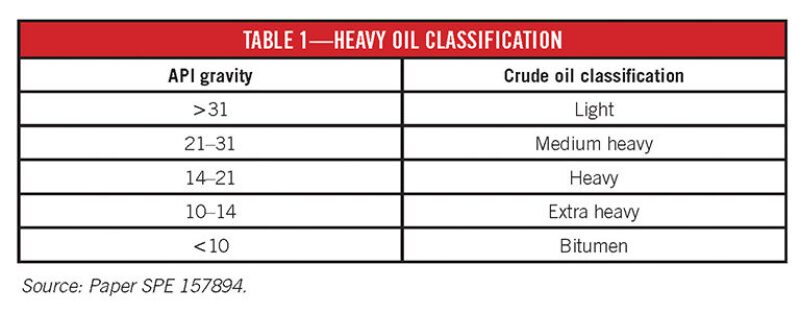At a September luncheon hosted by the SPE Gulf Coast Section’s Project, Facilities, and Construction study group, Wally Georgie of Maxoil Solutions addressed some of the critical factors associated with produced fluid characterization data that are frequently overlooked or misinterpreted.
“At the end of the day, when you are working with heavy oil, the question is how are we going to design your system,” Georgie said. He explained the process from two aspects: the layout of the system and the guts of the various vessels.
The terminology used to describe heavy oil is an important point. In his presentation, Georgie referred to oil with less than 23°API (Table 1). The production of heavy oil presents several processing challenges including the need for artificial lift, and difficult handling with respect to flow, separation, emulsions handling, storage, and transportation. It also demands high heating capabilities and requires large equipment. Solids production often will be associated with the processing of heavy oil and it typically generates more of the less-valued products.

Fluid Characterization
The design of a separation system relies on the accuracy and reliability of the fluid characterization data. According to Georgie, “Heavy oil is generally biodegraded oil, which means it contains many components you don’t normally have in standard crude oil.” These components give rise to flow assurance challenges.
During the appraisal phase of a new heavy oil field development, fluid samples are collected for pressure, volume, and temperature studies, oil assay analysis, and other tests. “It is important that good quality representative samples of oil and formation water also be collected,” Georgie said. Some of these samples are used for the accurate determination of fluid physical properties and production chemistry characteristics. “This is crucial information for any production and separation system basis of design,” he added.
In addition to test samples, laboratory test methods used to define the rheological properties and to characterize the production chemistry issues must also be fit-for-purpose for each system. Heavy and extra-heavy oils can exhibit unusual rheological properties and variable flow assurance characteristics during production and processing. “These must be properly defined,” Georgie said.
Separator Sizing
“The sizing of the separator is one of the biggest challenges in designing heavy oil facilities,” Georgie said. “You can’t shortcut the high residence time,” he added. Traditionally operators do not want large separators with high residencies. “The key thing when it comes to processing heavy oil is the need to ensure that the separators are the right size both in terms of allowing enough residence time and allowing enough space for the separation.”
Separation characteristics vary widely between oil fields. Variation in oil composition will require differences in residence times in separators and the need to enhance separation by other means. For light crude, traditional separators have residence times of around 4 minutes. For heavy oil, it is necessary to provide at least 20 minutes for the oil to properly separate, although it is not feasible to design separators large enough to accommodate this high residency time at each stage. It is necessary to design compromise solutions to create the optimal conditions for proper separation.
According to Georgie, there are several factors to consider when sizing separators for heavy oil developments because the basis of design begins with accurate fluid data and projected production data.
External devices can affect the quality of the outlet fluids either directly or indirectly. Many times the internal construction of a separator can improve processing. Separator internals for two- and three-phase separators are available in a range of commercial designs. One design feature that can take on a great amount of the work is the use of cyclonic inlet devices. “You can compensate larger-sized vessels by choosing the proper internals,” Georgie said. “In some cases the proper use of cyclonic design will do almost 75% of the work.”
“When you discuss challenges in heavy crude, you are really discussing the separation of the crude,” he said.
For Further Reading
SPE 157894 The Challenges in Processing Heavy Oil byWally Georgie and Colin Smith, Maxoil Solutions.

